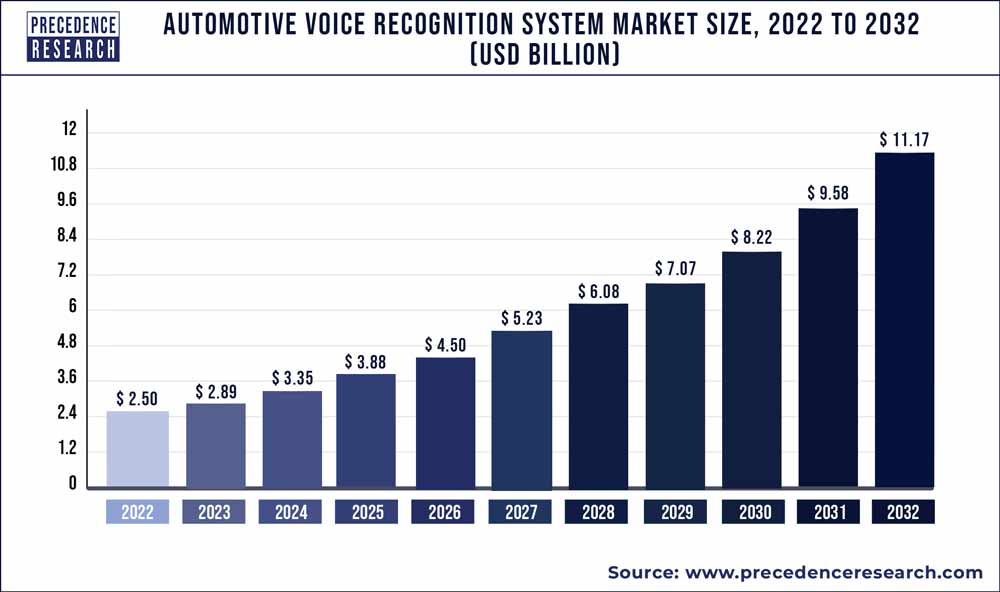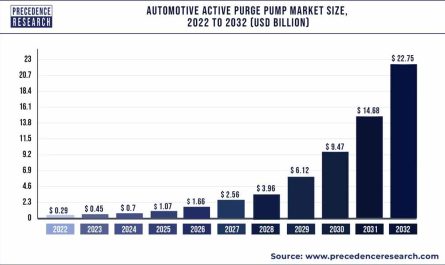The global automotive voice recognition system market size reached USD 2.89 billion in 2023 and is expected to hit around USD 11.17 billion by 2032 with a CAGR of 16.20% from 2023 to 2032.

The Automotive Voice Recognition System Market has witnessed significant growth in recent years, driven by the increasing demand for enhanced driver safety and convenience features in vehicles. Voice recognition technology has emerged as a key component in modern automobiles, allowing drivers to control various functions without taking their hands off the steering wheel or their eyes off the road. This technology enables drivers to make phone calls, adjust climate settings, navigate directions, and access entertainment options through simple voice commands. As automakers strive to deliver more intuitive and user-friendly driving experiences, the adoption of voice recognition systems is expected to continue expanding, shaping the future of automotive interfaces.
Get a Sample: https://www.precedenceresearch.com/sample/1393
Growth Factors
Several factors contribute to the growth of the Automotive Voice Recognition System Market. Firstly, the rising emphasis on driver safety and regulatory mandates regarding distracted driving have fueled the integration of hands-free technologies in vehicles. Voice recognition systems enable drivers to interact with infotainment and navigation systems without diverting their attention from the road, thereby enhancing safety. Additionally, the growing popularity of connected cars and the Internet of Things (IoT) has propelled the demand for voice-activated features, as consumers seek seamless connectivity and personalized experiences while on the move. Moreover, advancements in natural language processing (NLP) and artificial intelligence (AI) algorithms have significantly improved the accuracy and responsiveness of voice recognition systems, making them more reliable and user-friendly.
Furthermore, the increasing consumer preference for smart, intuitive interfaces in vehicles has driven automakers to invest in voice recognition technology as a competitive differentiator. As the automotive industry shifts towards autonomous and electric vehicles, voice-enabled control systems are expected to play a crucial role in facilitating human-machine interaction and enhancing the overall driving experience. Moreover, the integration of voice assistants such as Amazon Alexa and Google Assistant into automotive infotainment systems has broadened the scope of voice recognition applications, allowing drivers to access a wide range of services and content on the go. These factors collectively contribute to the robust growth of the Automotive Voice Recognition System Market.
Region Insights:
The adoption of automotive voice recognition systems varies across different regions, influenced by factors such as technological infrastructure, regulatory environment, and consumer preferences. In North America, particularly in the United States, the market for voice recognition systems is well-established, driven by the presence of leading automotive OEMs, technological innovation, and high consumer awareness. The region benefits from robust telecommunications networks and a tech-savvy population, which has accelerated the adoption of connected car technologies, including voice-activated features.
Similarly, Europe represents a significant market for automotive voice recognition systems, owing to stringent safety regulations and the presence of key automotive manufacturers. European consumers prioritize advanced driver assistance systems (ADAS) and infotainment features, driving the demand for voice-controlled interfaces in vehicles. Moreover, the European Union’s focus on reducing road accidents and improving road safety has further incentivized the integration of hands-free technologies in automobiles.
In Asia Pacific, the Automotive Voice Recognition System Market is witnessing rapid growth, fueled by the increasing adoption of premium and luxury vehicles equipped with advanced infotainment systems. Countries like China, Japan, and South Korea are at the forefront of automotive innovation, with a strong emphasis on in-car connectivity and intelligent voice assistants. The burgeoning middle-class population, rising disposable incomes, and changing consumer lifestyles contribute to the growing demand for voice-activated features in vehicles across the region.
Scope of the Automotive Voice Recognition System Market Report
| Report Highlights | Details |
| Market Size | USD 11.17 Billion by 2032 |
| Growth Rate | CAGR of 16.20% From 2023 to 2032 |
| Largest Market | North America |
| Fastest Growing Market | Asia Pacific |
| Base Year | 2022 |
| Forecast Period | 2023 to 2032 |
| Segments Covered | Technology, Application, Vehicle, Region |
| Companies Mentioned | Apple, Microsoft, VoiceBox, Alphabet, Sensory, Nuance, Harman |
Opportunities:
The Automotive Voice Recognition System Market presents several opportunities for industry players to capitalize on. Firstly, there is immense potential for further technological advancements in voice recognition technology, including improved natural language understanding, contextual awareness, and multi-modal interaction capabilities. As AI and machine learning algorithms continue to evolve, voice-controlled interfaces are expected to become more intuitive, responsive, and personalized, offering enhanced user experiences.
Moreover, the integration of voice recognition systems with other emerging technologies such as augmented reality (AR) and biometric authentication presents new avenues for innovation in automotive HMI (Human-Machine Interface) solutions. By leveraging AR overlays and facial recognition, automakers can create immersive and secure in-car experiences, enabling drivers to access information and control functions more efficiently. Additionally, the integration of voice-enabled commerce services and location-based recommendations opens up monetization opportunities for OEMs and third-party service providers, transforming vehicles into interactive platforms for content delivery and e-commerce.
Furthermore, the proliferation of voice-controlled smart home devices and IoT ecosystems provides opportunities for seamless integration between connected cars and smart home environments. By enabling cross-platform interoperability, automotive voice recognition systems can offer enhanced convenience and continuity of experience for consumers, allowing them to control home appliances, access personal data, and manage digital services from their vehicles. This convergence of automotive and smart home technologies presents a compelling value proposition for consumers and creates new revenue streams for automotive OEMs and ecosystem partners.
Challenges:
Despite the promising growth prospects, the Automotive Voice Recognition System Market faces several challenges that need to be addressed for widespread adoption and market penetration. One of the primary challenges is the complexity of natural language processing and the variability in human speech patterns, accents, and dialects. Achieving high levels of accuracy and reliability across diverse linguistic contexts remains a significant technical hurdle for voice recognition systems, especially in multilingual regions and global markets.
Moreover, privacy and security concerns surrounding voice data collection and processing pose ethical and regulatory challenges for automakers and technology providers. As voice recognition systems become more pervasive in vehicles, there is a growing need to establish robust data protection frameworks and ensure transparent consent mechanisms for collecting and utilizing voice data. Additionally, the risk of unauthorized access and malicious exploitation of voice-controlled interfaces raises cybersecurity concerns, necessitating continuous efforts to enhance system resilience and mitigate potential vulnerabilities.
Furthermore, user acceptance and adoption barriers may hinder the widespread uptake of automotive voice recognition systems. Despite advancements in technology, some consumers may perceive voice control interfaces as less reliable or intuitive compared to traditional input methods such as touchscreens or physical buttons. Overcoming user skepticism and skepticism through effective education, training, and demonstration of the benefits of voice recognition technology is essential to drive adoption and foster positive user experiences.
Additionally, interoperability and compatibility issues between different voice recognition platforms and automotive ecosystems pose challenges for seamless integration and cross-platform functionality. As consumers increasingly expect interoperability between their connected devices and digital services, automotive OEMs need to collaborate with technology partners and standards organizations to develop open and standardized interfaces that facilitate interoperability and ecosystem integration. Moreover, the rapid pace of technological innovation and the emergence of new market entrants pose competitive challenges for established players, necessitating continuous investment in R&D and strategic partnerships to stay ahead of the curve.
Read Also: Automated Parking System Market Size, Trends, Report 2032
Some of the prominent players in the global automotive voice recognition system market include:
- Apple
- Microsoft
- VoiceBox
- Alphabet
- Sensory
- Nuance
- Harman
Segments Covered in the Report
By Technology
- Embedded
- Cloud-Based
- Hybrid
By Application
- AI
- Non-AI
By Vehicle Type
- ICE
- BEV
By Geography
- North America
- U.S.
- Canada
- Europe
- U.K.
- Germany
- France
- Asia Pacific
- China
- India
- Japan
- South Korea
- Rest of the World
Contact Us:
Mr. Alex
Sales Manager
Call: +1 9197 992 333
Email: sales@precedenceresearch.com
Web: https://www.precedenceresearch.com
Blog: https://www.expresswebwire.com/
Blog: https://www.uswebwire.com/
Blog: https://www.dailytechbulletin.com/

